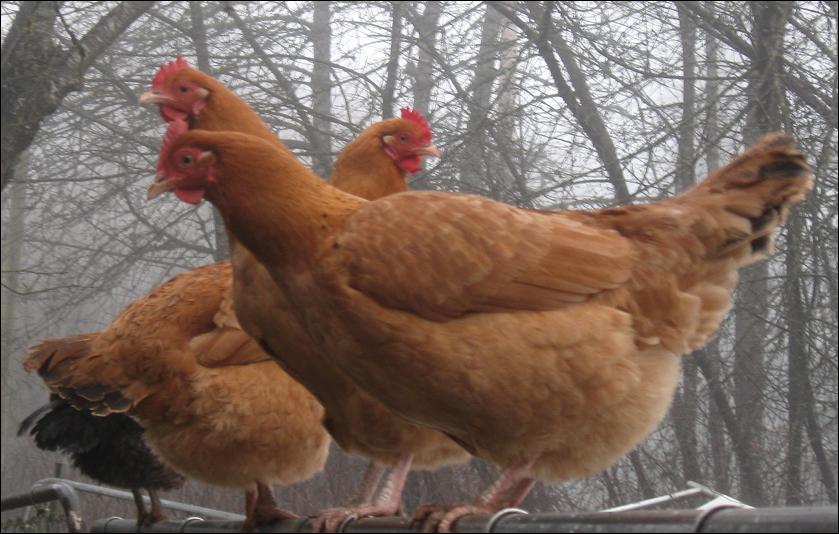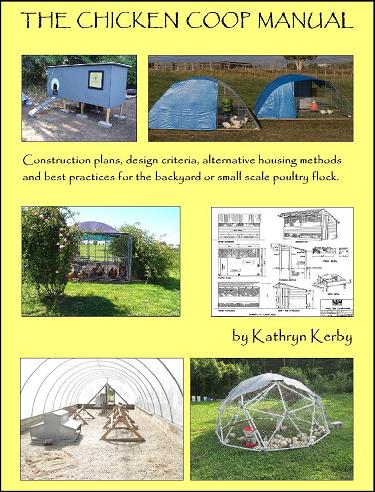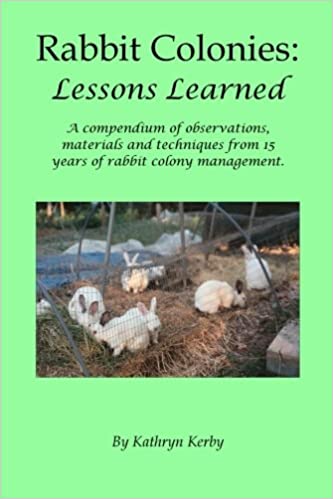|
Search this site for keywords or topics..... | ||

Custom Search
| ||
Chicken Coop:
Hot and Cold Weather Tips

The above birds are very comfortable outside on a calm, frosty, cloudy morning, with air temps hovering around freezing. If it were blowing or snowing, they would move inside very quickly.
Poultry coops must
fundamentally provide shelter from the weather, when weather conditions get
harsh. Birds are quite well equipped to
protect themselves against most weather, but they need at least some protection
from wind, rain, snow, and extreme heat.
Some guidelines would be that temperatures below about 20F or above 95F
start to test birds, with the former causing some chill issues and the latter
causing overheating issues. Let's take a look at some specific issues, and solutions.
Hot Weather Issues
High temperatures, ie 95F or above, need to be modified with shade, ventilation or both. If a bird is panting, they need increased ventilation, access to water and/or access to shade to help carry off the heat build-up and prevent heat stress.
Lighter-weight birds can usually tolerate such temperatures fairly easily. If temperatures are only going to be in the 90's for a few hours, say on a sunny summer afternoon, shade and a water source are typically sufficient for these breeds. Heavier breeds and broilers, however, are more sensitive to heat issues because their larger mass makes it harder for them to cool down. So households and farms with heavier breeds and/or broilers need to be more cautious in this regard, and either be ready to provide, or already have, hot-weather relief for their birds.
Aside from access to shade and fresh water, one additional cooling technique is simply to provide a fan blowing a good stiff breeze through the shaded area. For instance, assuming the coop already has ventilation such that it is cooler inside than out, mounting a fan to blow air through the roosting area will provide excellent cooling for a layer flock. The birds most impacted by heat will quickly learn to roost in that moving air, and will be much more comfortable as a result. For broilers, it can get a little trickier because they are usually on the ground and do not have access to a roost. In that instance, mounting a fan is a good option if there is already power to the broiler pens. If not, try moving the entire pen to a part of the pasture which has extended shade all afternoon. Or mount a shadecloth as a sunblock for the pen. Most situations can be made comfortable if different techniques are tried out.
One additional note. Some breeds are specifically tolerant of heat, and will not require such careful measures. For those flock owners in particularly hot climates, check with neighboring flock owners and/or small-scale poultry farms to see which breeds work well, and which do not. Try to speak to small-scale operations, because large commercial-scale egg farms have climate-controlled facilities where temperatures are not allowed to get so hot. Yet the small farm or the backyard flock owner may have very good information on which breeds work for that climate. Additionally, keep in mind that birds with large combs generally tend to do better in hot climates. Those combs help them shed heat buildup. So breed selection can make a bid difference for bird survival in hot climates.
Cold Weather Issues
If the weather is cold, the birds do alright in calm air but will get chilled very quickly in any kind of wind. In that circumstance, they need at least a windbreak so that they can fluff themselves up and increase their own insulation. Be particularly aware of birds who are going through a molt during cold weather - they may not have the bulk of feathers the need to provide for their own insulation. In sustained cold weather, all birds in general will need a richer diet to bring in the calories they’ll need to keep themselves warm. And then there’s the issue of precipitation. Birds do not like getting wet. A soft rain in mild conditions is no problem; we’ve had birds who insisted on roosting outside through our very rainy autumn and spring climate. But when the temps go below about 40F, birds can’t dry off or stay warm enough if they remain wet. So wintertime requires a roof and walls such that the birds can get out of wind-driven rain and snow.
Most coops won’t need supplemental heat as long as the birds
can get into dry shelter. However, birds
in some northern climates do benefit from supplemental heat. During the worst of our weather, we provide
one or two heat lamps to the birds so that they can warm up under the lamp,
then go about their day. Most birds will
only spend about 20 minutes under the lamp before they move on, so only a few
lamps are quite sufficient for the whole flock.
However, a bird that camps out all day under a lamp in anything but the coldest
weather, is almost certainly sick and is impacted more severely by the cold. We generally pull such birds out of the coop
and put them inside warmer quarters for our generally short-lived cold snaps. That gives the birds a chance to recover without getting a full-blown
illness. Those folks in far northern
climes may want to look for and specialize in breeds which are well adapted to
cold conditions, so that few birds if any, will require such additional
treatment. Along these lines, some
breeds are much more suited to cold temperatures than others. Any bird with a compact comb is better suited
to cold conditions than a breed with a long, tall, exposed comb. Those combs are little radiators and the
birds can lose a tremendous amount of heat through those combs. They are also very prone to frostbite. Rose combs in particular are much less prone to cold damage.
Poultry Books
Sponsored Products
Our Successful Farming and Ranching Books

We released our very first self-published book. The Chicken Coop Manual in 2014. It is a full color guide to conventional and alternative poultry housing options, including 8 conventional stud construction plans, 12 alternative housing methods, and almost 20 different design features. This book is available on Amazon.com and as a PDF download. Please visit The Chicken Coop Manual page for more information.

Rabbit Colonies: Lessons Learned
We started with rabbits in 2002, and we've been experimenting with colony management ever since. Fast forward to 2017, when I decided to write another book, this time about colony management. The book is chock-full of practical information, and is available from both Amazon and as a PDF download. Please visit the Rabbit Colonies page for more information.
The Pastured Pig Handbook
We are currently working on our next self-published book: The Pastured Pig Handbook. This particular book addresses a profitable, popular and successful hog management approach which sadly is not yet well documented. Our handbook, will cover all the various issues involved with pastured hog management, including case studies of numerous current pastured pig operations. If you have any questions about this book, please Contact Us.